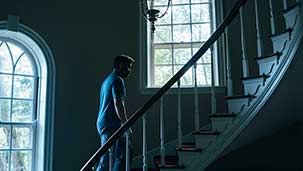It makes sense that a film so finely calibrated could pivot on whether a watch strap is made of leather or steel. But it really does—although in ways that are both convoluted and often unsettling.
Every set, every piece of furniture, and yes, every watch strap in The Killing Of A Sacred Deer signifies something essential. The colour palette—crisp whites and pastels for the well-to-do, dull and washed out for the have-nots—is only one of the layers of the production design that underscores the themes director Yorgos Lanthimos is playing with here.
I’m not exactly sure how to describe The Killing Of A Sacred Deer. Is it a black comedy/satire/harangue that is so fiercely wrought it can make you wince in the middle of a laugh? Or is it simply a mirror reflecting back exactly what it sees in the bougie decline of late stage American capitalism?
Colin Farrell is a cardiologist with a family so surface perfect that initially it feels like a parody. Soon though, that facade is stained by an enigmatic young man who insinuates himself into Farrell’s picture perfect tableaux. After that things take a bit of a turn.
This is a film that requires close watching. So much of the story revolves around Farrell’s relationship to his possessions, and the obsessive attention to the details of his life that signal where exactly he rests on the hierarchical ladder. His car, clothing, office, home, accessories, furniture, the paint on his walls, the colour of his couch, the clothes his wife and children wear, feel as if they were co-ordinated with a singular purpose. All of these talismans of status are important because of what they project to the rest of the world, far more than the material purpose they serve.
That these details are fundamentally more important to Farrell than his actual family may seem like a banal assertion, but only to someone who hasn’t seen the last third of the film. This inversion of priorities and how prevalent that mindset is within a small, but incredibly influential, segment of American society is something Lanthimos dissects with a finely honed scalpel. And it isn’t so much that these are uniformly terrible people—even the children—but that their motivations and calculations are so solipsistic and empty. Not a one of them seems even close to happy but they plod along like automatons, as if they long ago had lost the capacity to make different choices.
It was an interesting choice to lavish so much attention to minutiae in the production design, not just for the visual effect, but because it was important in a much deeper sense. Just watching someone walk into a new room is a surreal experience; you can anticipate its decor because of the unanimity of the film’s overall aesthetic. Which is an echo of Farrell’s own compulsive self-regard when it comes to the front his character conspicuously presents.
What makes this film important, and worth grinding through—and it is a grind, no question—is you and your production team never lose sight of what really matters: that those details have to add up to something other than a brittle, pointless exhibition.
Sincerely,

Tim







